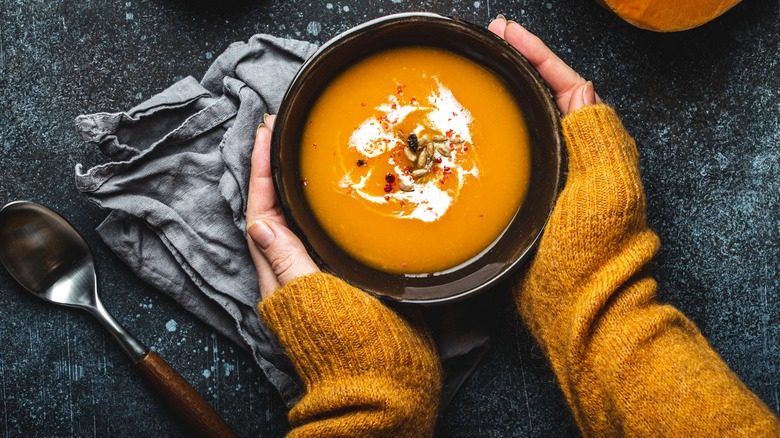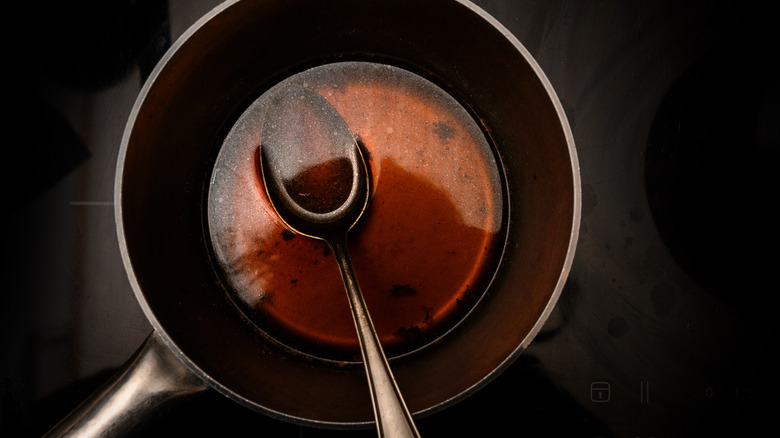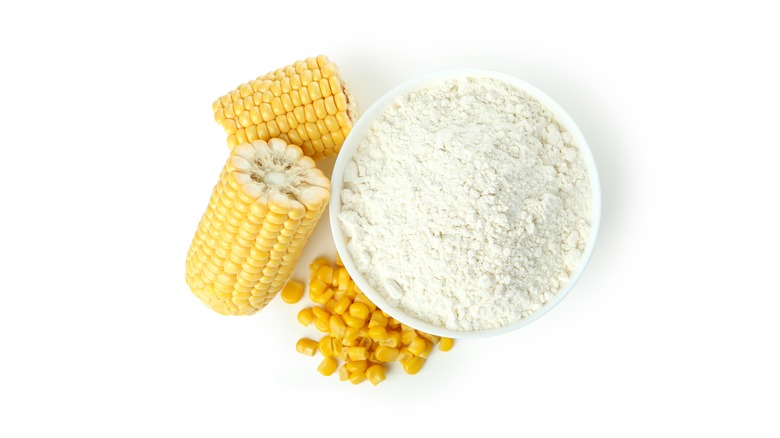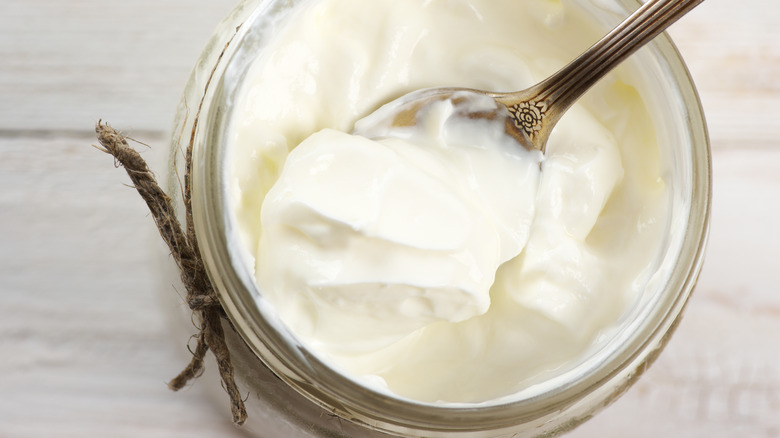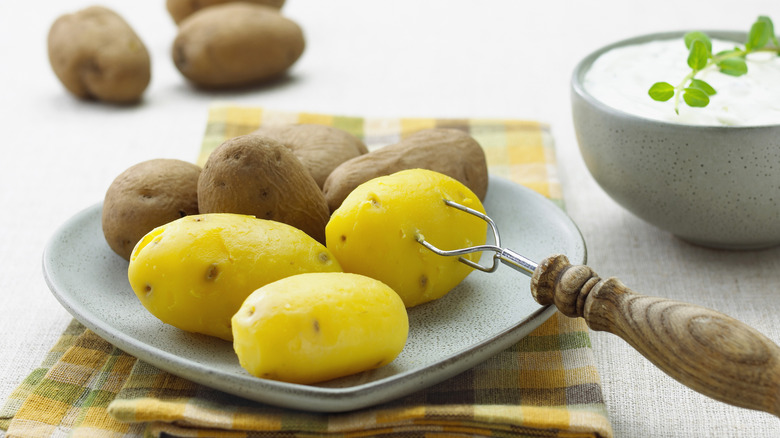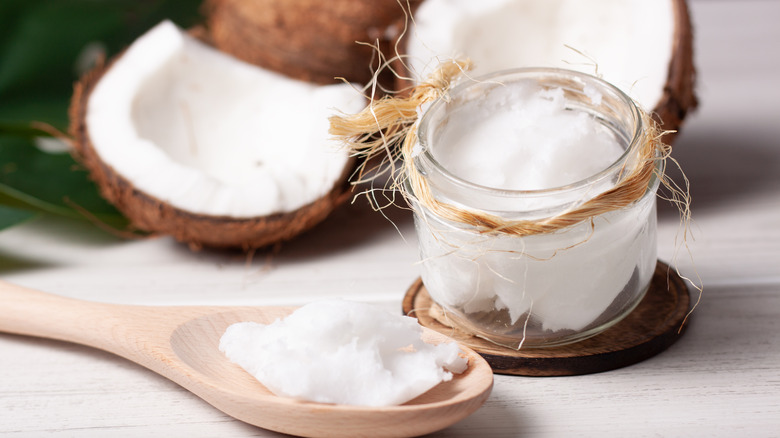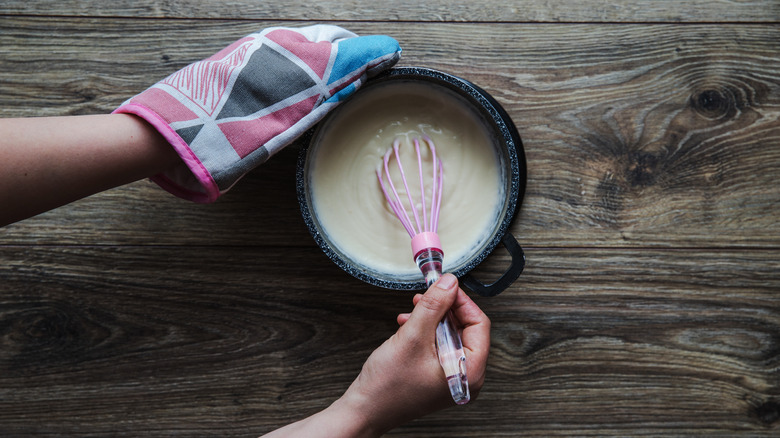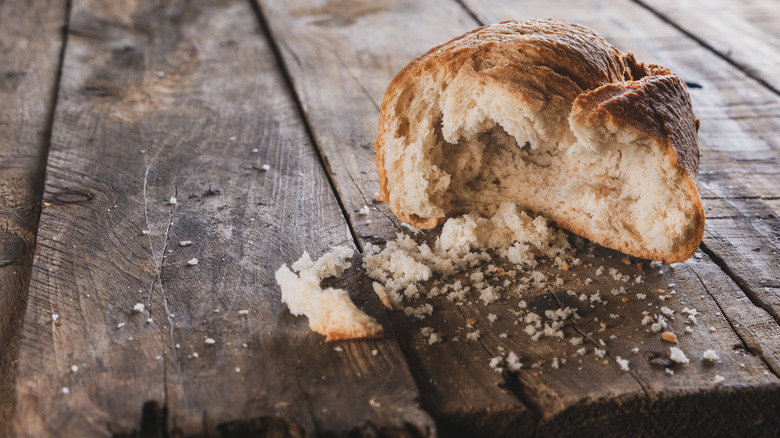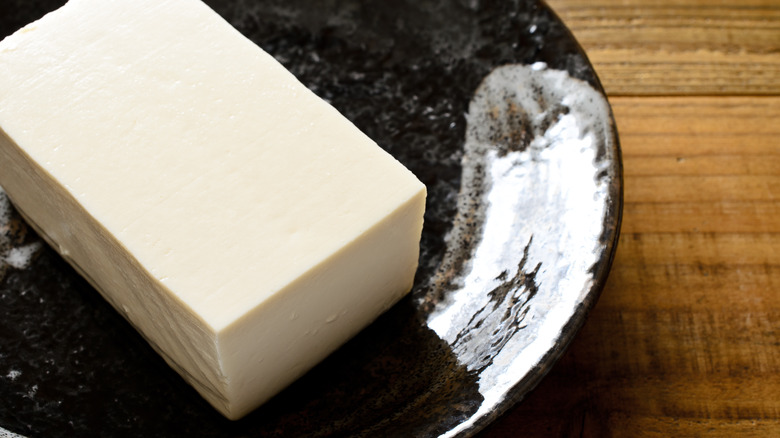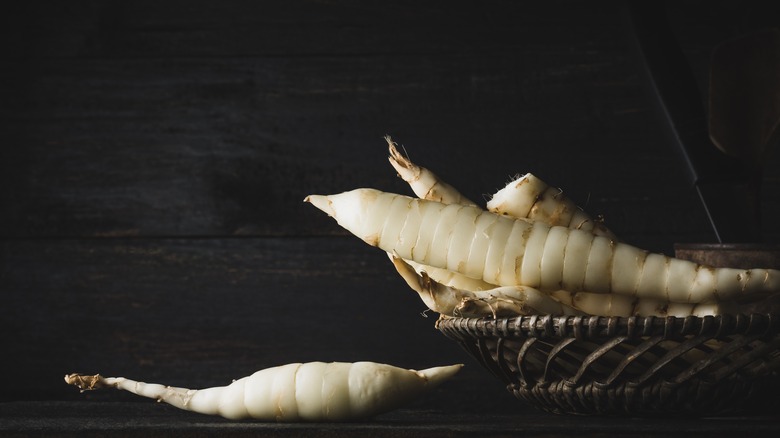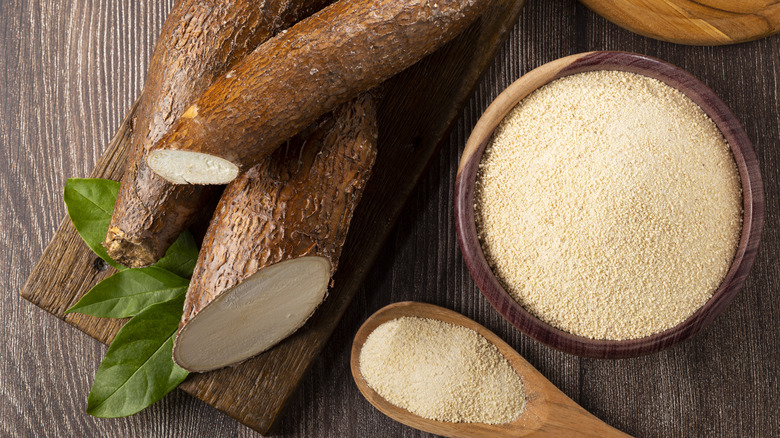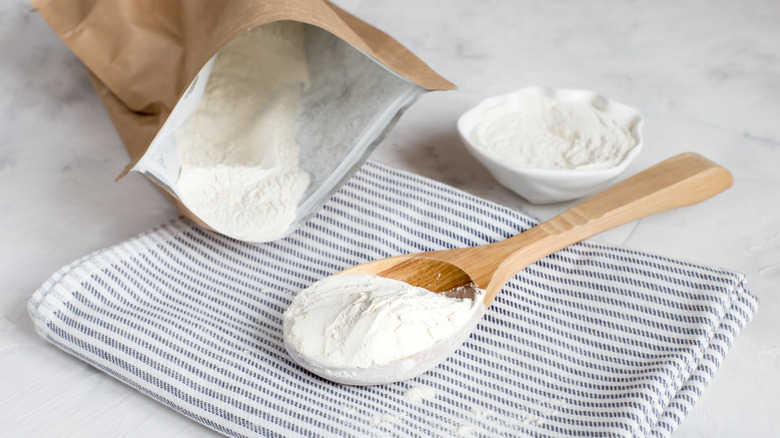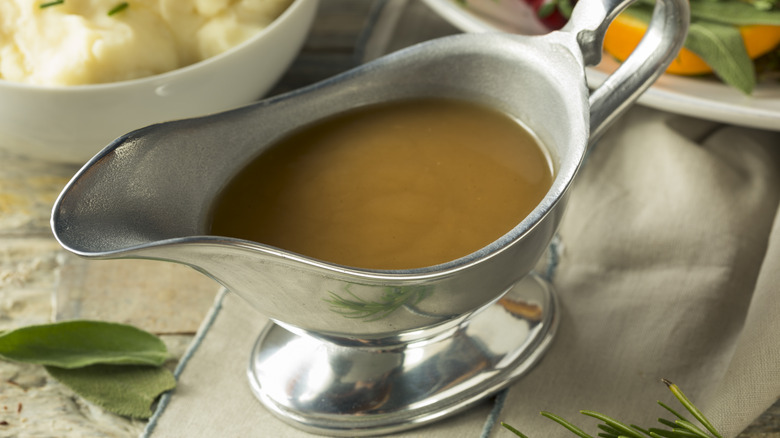The 14 Ways To Fix Your Runny Soup
We may receive a commission on purchases made from links.
Whenever you see an elegant composition of clarified broth and precisely chopped greens, or a chunky mess in a rustic bowl, it gives an immediate feeling of comfort, like a hot, soothing bath for the body and soul. It's hard to define a perfect soup because it's a very personal experience closely tied to our childhood memories and cultural heritage.
We can find an answer to the question of what makes soup so indulging by examining the science of mouthfeel and flavor. According to a 2013 study published in Current Opinion in Colloid & Interface Science, there are several stages of oral processing of food, each of which is responsible for the overall experience we find pleasing to our palate. The way food coats our mouth and the time it takes to be swallowed can be attributed to the viscosity or texture of the food. Each type of dish we consume has the ideal viscosity for that particular food, so we always know when the soup has become too runny.
But what if you do it wrong? No need to panic. We can easily improve the mouthfeel of any soup by refining its thickness and texture. So before you throw in the towel, read on to find a dozen old tricks and useful techniques for food thickening that will ensure your soup is amazing. You can thank us later.
1. Make a reduction
Maybe you've cooked the recipe and are now getting ready to write the author a review blaming them for all your mishaps in the kitchen. Before you do that, let's see what you can do to serve your guests something of which you can still be proud. Sometimes the solution is right under your nose.
Depending on what kind of soup you're making, the first and most obvious solution is a simple reduction, per Food Republic. This works especially well with blended soups but can be applied to any soup that doesn't lose its visual appeal from prolonged cooking. Simply crank up the heat, leave the pot uncovered, and let the water boil out. Not only does this reduce the amount of liquid, but it also concentrates the flavor and opens up the depths of the umami in your dish. Be sure to add the salt at the end, or it'll be very salty.
If your soup is full of veggies, you can also take a quarter or a third of it, puree it in a separate bowl, and add it back into the soup pot. By doing so, you won't lose any of the liquid goodness and your soup will be thicker.
2. Play with starchy ingredients
Another great way to thicken your soup is by adding an element of interest. With a few common starchy ingredients from your pantry, you can easily make a thin soup firmer and more nutritious. Chances are you'll have some pantry staples on hand, such as dried pasta, quinoa, rice, or beans. Depending on the soup you're making, these ingredients can add substance to an otherwise watery base.
According to Medical News Today, starchy foods are an important source of energy for our bodies and keep us feeling full longer. These foods also contain fiber, which is essential for normal digestion. Starch isn't only good for your health, but it also acts like a binder, soaking up the extra juices and giving your dish a slightly sticky appearance. Don't overdo it though, as a handful is quite enough.
So what should you add and when? There are plenty of recipes that already include legumes or pasta. We advise you to think about the cuisine where your ingredients originate. If you're making a seasonal vegetable soup, adding rice or cannellini beans would be an excellent choice. A red, white, and bean minestrone soup is a good example. It's usually quite thick, and dense, and contains more than one starchy ingredient. You can also try blending them into the soup, as we discussed earlier.
3. Learn how to make a slurry
Perhaps one of the most popular food thickeners is cornstarch or corn flour, which can be mixed with water to make a slurry. Before adding the slurry to a runny soup, the starch must be dissolved in cold water. According to Bon Appetit, if we put the starch directly into the bubbling liquid, it would form lumps that can easily ruin your meal for good.
A slurry can also be made from other starches, such as flour or potato, each of which adds a slightly different texture to the dish. Cornstarch is almost flavorless, which is probably why it's most commonly used to make a slurry to thicken soups. Although, you should use it sparingly as it has twice the thickening power of regular flour. The trick to using cornstarch is to start with a slurry and add it to the soup pot over low heat. Stirring thoroughly, you can then bring the soup to a boil for a few minutes. Reduce the heat again, check the consistency, and voila! At this point, you'll know if you need to repeat the process to achieve the desired consistency.
4. Brighten and thicken your soup with dairy
You'll find many recipes asking for a generous dollop of cream at the end. Heavy cream, half and half, or yogurt — all of these can be your ticket to an utterly delicious bowl of thick and creamy soup. It can also help bind a soup that didn't quite go as planned. The key here is timing. The emulsion that makes cream so fluffy and airy can easily be destroyed by heat, per MasterClass. So the best way to use it is to mix it in right after you have finished cooking.
Speaking of heat, according to a 2019 study published in the Journal of Physiology and Behavior, dairy products have been shown to reduce the heat of capsaicin found in chilis. That means you can adjust the thickness and spice level of the soup at the same time. But be careful: If you add a lot of cream, the flavor could be weakened, so you may need an extra pinch of salt or other spices.
5. An essential chef's trick to fix a thin soup
The potato is often regarded as a humble vegetable queen. From a silky and smooth potato soup to a classic leek and potato soup, this buttery root vegetable lends itself to countless recipes. Chefs often combine it with onions to create a perfect base for any creative soup blends you can imagine. But the potato can also save the day when your soup is too thin as it acts as a great thickener.
Potatoes can thicken soups in several ways. If you're making a blended soup, cook the potatoes with their skins on, then mash and combine to not only thicken the base but add additional flavors and a silky appearance. If you aren't going to blend it but the base still needs to be a little thicker, boil the potatoes whole, which will allow the starches to release into the liquid. You can then either leave them in as an additional ingredient or remove them.
Celebrity chef Jacques Pepin offers another secret tip to thicken soups with potatoes (via Kitchn). On an episode of "More Fast Food My Way," he confessed that he uses plain potato flakes (instant mashed potatoes) as a finishing touch for his leek and potato soup. They work similarly to potato or corn starch, but with less risk of becoming lumpy. Now that's a game changer.
6. Add a tropical twist with coconut cream or milk
What could be more satisfying than the tropical scent of a freshly opened coconut? Starting with the celebrity craze for coconut water, this tropical superfood has been steadily gaining ground in the specialty food sector (via SFA), with a huge variety of products, such as coconut water, oil, milk, cream, and even yogurt ,now hitting the shelves. The global trend toward dairy-free alternatives has finally given chefs and cooks the opportunity to be bold and experiment with fusion cuisine.
Whether you're lactose intolerant or want to add an exotic twist to a Western dish while thickening it at the same time, you can substitute equal parts dairy with coconut cream or coconut milk. Be careful, though, as it too contains emulsified fat that can easily break down when heated. Stir it in carefully at the end so that it can fully develop its creaminess.
7. Mix in a roux
Roux is probably one of the oldest culinary techniques for thickening sauces. It was invented at the French court of the Sun King in the 17th century, per Michelin Guide, and led to the legendary 5 French "mother" sauces that are still the basis of every culinary textbook.
Traditionally, roux is made by melting butter over low heat and then stirring in flour until a paste is formed. As MasterClass explains, the browning of the paste defines the four types of roux: white, blond, brown, or dark brown. While the first three are most common in France and Europe, the dark brown roux has been adopted by Creole and Cajun cuisine. It's usually made with oil or lard and browned much longer for a rich, caramel base.
After browning, slowly stir in the liquid of your choice, such as milk, broth, or soup, until the mixture is fully incorporated. Once you've mastered this technique, you won't have to worry about runny soup ever again.
8. Give your old bread a second chance
Every time we go through the pantry, we're almost certain to find a piece of stale bread. Sometimes it's just laziness that makes it invisible to us, or the fresh bread it's hiding behind is to blame; in one way or another, we've all been guilty of it. The good news is that we can give it another chance before it's condemned to death. Adding it to a soup that's gone wrong is one way to both use up old bread and thicken your dish.
In some cultures, bread is a common ingredient in soup making. In Mexico, for example, bread is often found in soup recipes in old cookbooks (via History at BGSU), while the Italian soup pancotto is made with stale bread, per La Cucina Italiana.
If you don't mind the rustic vibes, adding it to your runny soup is a fantastic way to soak up all the liquid. The bread needs to be hard enough so that it has enough time to soften but retain some texture, similar to croutons. If you don't have stale bread lying around, you can also toast fresh bread in the oven before adding it to your soup.
9. Add some cheese for an extra zing
Avery Aames, the best-selling author of "A Cheese Shop Mystery," once said, "Life is great; cheese makes it better." We couldn't agree more. It's rich, flavorful, and a great thickener for soups. When used right, it can add an exciting spin to your recipe.
The next time you're in a situation where you need to save a meal, check your fridge for cheese. Cheeses have different melting properties that will determine how best to use them. To make it simple: The more water the cheese contains, the lower the temperature at which it will begin to melt (via MasterClass), so mozzarella, cheddar, gouda, or feta would be a good place to start. Crumble or shred it into your soup and puree it with a hand blender on low heat until it's the right consistency.
Hard, aged cheeses like Parmesan contain very little water, but the flavor is much more concentrated. Not only does it need a higher temperature to melt, but to make the soup creamy, you'll need to add a sizeable chunk. Although, if your soup tastes very bland, a lump of hard cheese can also do wonders.
10. Make it a velvety delight with silken tofu
Tofu seems like a rather unorthodox way to fix a runny soup, but wait until you try it. It comes in many varieties, yet for the best results, silken tofu is the way to go.
While solid tofu can make your dish grainy, the fluffiness of silken tofu will blow you away. It's called silken tofu for a reason, as in Japan it was originally made using cloth covered in silk (via Earth Food Source). Unlike other types of tofu, silken tofu isn't pressed or drained, so the curds remain untouched. This technique creates an extremely soft and delicate tofu that literally melts in your mouth.
The pudding-like consistency and neutral flavor make it an ideal companion for pretty much any soup base. Be sure to add enough flavor to balance out the tofu and we guarantee you'll be adding it to your next shopping cart.
11. Discover the benefits of arrowroot
Arrowroot is a tropical tuber native to Indonesia that is an excellent thickener due to its high starch content (via Healthline). Similar to sweet potato, cassava, or yam, the root itself can be used, but it may be difficult to find it in your nearest supermarket. Arrowroot powder extracted from the plant is a common alternative and very useful for stirring into your soup.
Because of its neutral taste and thickening properties, the powder is often used as a substitute for cornstarch or flour in recipes. It also becomes active at much lower temperatures, so it's best to prepare it as a slurry first and then add it to your soup over low heat, per The Culinary Pro. Arrowroot doesn't break down on contact with acidic foods or in the freezer, making it a very versatile thickener. If you use it as a substitute, 2 teaspoons of arrowroot should be enough for 1 tablespoon of cornstarch.
According to Healthline, arrowroot has a number of potential health benefits as well. Not only does it contain more protein than other tubers, but it can also boost your immune system and help you lose weight. All in all, arrowroot is a healthy ingredient that perfectly thickens soups.
12. Use tapioca flour or starch
Tapioca is another thickener from a tropical tuber family that works wonders in soup. It is extracted from the cassava root and is usually sold as tapioca flour or tapioca starch. There's a catch, though: Sometimes it's called cassava flour, which is produced from the whole plant, while tapioca flour is just pure starch, per Bob's Red Mill. We know this is confusing, so make sure you read the label before grabbing a bag.
If you are fixing a soup, tapioca flour (or starch) works best. As with any starch, you should make a slurry and then add it to the pot on simmer while whisking continuously. This will give your soup a nice opaque viscosity reminiscent of pudding. You might also come across tapioca pearls, another form of tapioca used in bubble tea or cold desserts. If you're feeling adventurous, they add a nice chewy texture to a sweet soup.
13. Don't be intimidated by xanthan gum
Due to its far-reaching possibilities, Modernist Cuisine called xanthan gum "one of the best discoveries in food science since yeast." It is used throughout the food industry as a thickener and stabilizer in everything from restaurant dishes to shelf-stable products. It offers incredible versatility and thickening power, requiring only 0.1% by volume.
With such power comes responsibility, which is why we think xanthan gum can sometimes seem intimidating at first. The truth is, using it is easier than it looks, and you can put it to great use when cooking at home. All you need is a small digital scale and a whisk (or an immersion blender). It works with both cold and hot liquids, and you don't have to make a slurry — just measure it out and mix it in thoroughly. One thing to keep in mind, however, is that once xanthan gum sets, reheating it may take away some of its effectiveness, per "Modern Pastry and Plated Dessert Techniques" via BCCampus.
14. Stir in homemade gravy or gravy mix
We'll share a saucy tip we've been saving for the end. It's quick and efficient and not only helps thicken a soup, but also adds some depth. Many soups start with some form of broth, which provides a deep and subtle base. Gravy, on the other hand, has a much more concentrated, umami richness that can cleverly be turned into a thickener for a soup.
Traditionally, it is made from the meat juices in the pan, followed by a whisked roux and some stock. We do have a shortcut, however — a convenient dry gravy mix or granules. It usually contains the full spectrum of starches, gums, meat, fish or vegetable flavorings, and dried herbs — pretty much everything you need to quickly fix your runny soup. We definitely recommend an organic and natural gravy mix, as it won't contain artificial colors and flavorings that don't compliment the nourishing bowl of goodness you just made. Giving up on meat? You can easily find a veggie alternative to experiment with as well!
